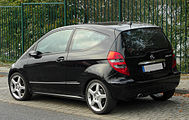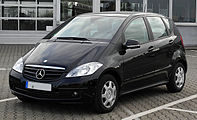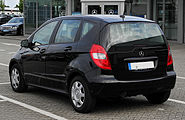Mercedes-Benz series 169
| Mercedes Benz | |
|---|---|
|
Mercedes-Benz A-Class (2004-2008)
|
|
| Series 169 | |
| Sales designation: | A class |
| Production period: | 09 / 2004-04 / 2012 |
| Class : | Compact class |
| Body versions : | Station wagon |
| Engines: |
Otto engines : 1.5–2.0 liters (70–142 kW) Diesel engines : 2.0 liters (60–103 kW) |
| Length: | 3838 mm |
| Width: | 1764 mm |
| Height: | 1593 mm |
| Wheelbase : | 2568 mm |
| Empty weight : | 1195-1365 kg |
| Previous model | Mercedes-Benz series 168 |
| successor | Mercedes-Benz W 176 |
| Stars in the Euro NCAP - Crash Test (2005) |
|
The Mercedes-Benz series 169 is a vehicle type of the German automobile brand Mercedes-Benz with front-wheel drive , which was sold under the name " A-Class ".
Model history
The 169 series replaced the first generation vehicle type ( 168 series ) in October 2004 . With the new edition, a three-door variant was also available, which is also known as the C 169 . A long version, as with the predecessor (V 168), was no longer available.
Model development
- September 2004: order approval
- October 2004: Market launch of the A 150, A 170, A 200, A 160 CDI, A 180 CDI and A 200 CDI models
- November 2004: three-door model (coupé) available
- December 2004: Autotronic (continuously variable automatic transmission) available
- June 2005: facelift "model year 2006"
- July 2005: Introduction of the A 200 Turbo model, soot particle filter now standard on diesel
- February 2006: Special model "Polar Star"
- September 2007: special model "EDITION 10"
- Spring 2008: Facelift of the model series, which was available from June 2008 with the introduction of the A 160 CDI BlueEFFICIENCY .
- June 2009: Renaming of the A 150 to A 160 and the A 170 to A 180, otherwise no technical changes; also special model "Special Edition"
- July 2010: Production of the three-door coupé version ceased due to poor sales.
- October 2010: End of production of the A 200 Turbo
- April 2012: End of production of the W 169 on April 19, 2012. The successor W 176 appeared on September 15, 2012.
Furnishing
Like most vehicles of the Mercedes-Benz brand, the 169 series was also offered in three equipment lines:
- Classic / standard equipment (from the facelift) has steel rims and plastic inlays in a high-gloss black piano lacquer look.
- Elegance has, among other things, aluminum rims , wooden inlays, leather elements. 4-way electric window lifters were standard up to the facelift, most recently subject to a surcharge.
- Avantgarde has, among other things, aluminum rims, leather elements, aluminum decor and a “sportier” look.
The optional automatic transmission is a continuously variable CVT transmission .
Occupant safety
Thanks to the innovative design, the engine can slide under the passenger cell in the event of a frontal collision, effectively reducing the consequences of accidents for the occupants; the vehicle itself suffers a total loss if shifted. The Mercedes engineers had this revolutionary design of the front structure patented:
- DE 43 26 396 C2 "Motor vehicle with a drive motor inclined at an acute angle to the horizontal"
- DE 44 00 132 C1 "Front wall structure for a motor vehicle with a drive unit arranged at the front"
Thanks to this design and the sandwich floor, the occupants sit significantly higher than in other vehicles, which is also an advantage in side-impact accidents. Disadvantages of the high structure are a higher center of gravity and the large frontal area.
The following safety features are standard:
- Adaptive front airbags
- Active headrests
- Belt tensioners for the front and rear seats and belt force limiters for the front seats
- Electronic stability Program
- Head / thorax airbags
The following are available at an additional cost:
- Sidebags for the rear
- Windowbags
Child seats can only be securely attached to the back seat on the outside seats. Isofix brackets are also available there. For a surcharge, there is an automatic child seat recognition for the front passenger seat, which deactivates the front passenger airbag ( AKSE ). However, this only works with baby seats that are available from Mercedes dealers.
The 169 series reached the EURO-NCAP - Crash test the highest rating of five stars.
Special equipment features (partly special equipment)
- Bi- Xenon headlights with cornering light
- Autotronic continuously variable automatic transmission
- Comand APS DVD navigation
- Electronic stability Program
- Panoramic louvre sliding roof
- Particulate filters for diesel engines
- Hill start assist
- PDC front and rear (Park Distance Control, parking aid)
- Parking assistant (independent parking)
- Linguatronic (voice control for radio, CD, navigation, telephone including telephone and address book)
Engine variants
The 169 series was available with seven different four-cylinder engines. The engines with the designation CDI are diesel engines with common rail injection and turbocharger .
The models with the additional designation BlueEFFICIENCY were only available with a manual 5-speed gearbox, the models of the same name without this additional designation only with a continuously variable automatic transmission. The A 200 model was available with both a continuously variable automatic transmission and a manual 5-speed transmission, the A 180 CDI, A 200 CDI and A 200 Turbo models optionally with a continuously variable automatic transmission or a manual 6-speed transmission.
| model | Construction period |
Engine designation |
Displacement | power | Torque 1 |
Top speed 1 |
Combined consumption 1 (l / 100 km) |
Acceleration, 0–100 km / h 1 |
CO 2 emissions 1 |
|
Gasoline engine
|
|||||||||
|---|---|---|---|---|---|---|---|---|---|
| A 150 | 2004-2009 | M 266 E 15 | 1498 cc | 70 kW (95 PS) |
140 Nm at 3500 rpm | 175 km / h | 6.2-6.7 | 12.6 s | 148-159 g / km |
| A 160 | 2009–2012 | M 266 E 15 | 1498 cc | 70 kW (95 PS) |
(140 Nm at 3500-4000 rpm) | 170 km / h | 6.8-7.2 | 13.5 s | 159-168 g / km |
| A 160 BlueEFFICIENCY | 2009–2012 | M 266 E 15 | 1498 cc | 70 kW (95 PS) |
140 Nm at 3500-4000 rpm | 175 km / h | 6.0-6.2 | 12.6 s | 139-143 g / km |
| A 170 | 2004-2009 | M 266 E 17 | 1699 cc | 85 kW (116 hp) |
155 Nm at 3500 rpm | 188 km / h | 6.6-6.8 | 10.9 s | 157-163 g / km |
| A 180 | 2009–2012 | M 266 E 17 | 1699 cc | 85 kW (116 hp) |
(155 Nm at 3500-4000 rpm) | 183 km / h | 6.8-7.3 | 11.5 s | 159-171 g / km |
| A 180 BlueEFFICIENCY | 2009–2012 | M 266 E 17 | 1699 cc | 85 kW (116 hp) |
155 Nm at 3500-4000 rpm | 188 km / h | 6.3-6.6 | 10.9 s | 146-153 g / km |
| A 200 | 2004–2012 | M 266 E 20 | 2034 cc | 100 kW (136 hp) |
185 Nm at 3500-4000 rpm | 200 (195) km / h | 6.7-6.8 (7.4-7.6) | 9.8 (9.9) s | 156-159 g / km |
| A 200 turbo | 2005-2010 | M 266 E 20 AL | 2034 cc | 142 kW (193 hp) |
280 Nm at 1800-4850 rpm | 228 (220) km / h | 7.5-7.7 (7.9-8.1) | 7.5 (7.3) s | 178-182 g / km |
|
diesel
|
|||||||||
| A 160 CDI | 2004–2012 | OM 640 DE 20 LA red. | 1991 cc | 60 kW (82 PS) |
180 Nm at 1400–2600 (200 Nm / 1400–2600) |
165 km / h | 5.4-5.8 | 15.3 s | 142-154 g / km |
| A 160 CDI BlueEFFICIENCY | 2009–2012 | OM 640 DE 20 LA red. | 1991 cc | 60 kW (82 PS) |
180 Nm at 1400-2600 | 170 km / h | 4.5-4.7 | 15.0 s | 118-125 g / km |
| A 180 CDI | 2004–2012 | OM 640 DE 20 LA red. | 1991 cc | 80 kW (109 PS) |
250 Nm at 1600-2600 | 186 (181) km / h | 4.9-5.2 (5.4-5.8) | 10.8 (11.1) s | 128-138 g / km |
| A 200 CDI | 2004–2012 | OM 640 DE 20 LA | 1991 cc | 103 kW (140 PS) |
300 Nm at 1600–3000 (280 Nm / 1600–3000) |
201 (196) km / h | 5.1-5.3 (5.5-6.0) | 9.5 (9.6) s | 135-139 g / km |
The engine designation is encoded as follows.
- Gasoline: M = engine, series = 3 digits, E = manifold injection, KE = port injection, A = exhaust gas turbocharger, L = charge air cooling, red. = reduced performance.
- Diesel: OM = oil engine, series = 3 digits, DE = direct injection, L = charge air cooling, A = exhaust gas turbocharger, red. = reduced performance.
Remarks:
- Diesel vehicles with standard particulate filters
landing gear
The front wheels are individually suspended on MacPherson struts and wishbones, a rigid drawbar axle is installed at the rear, which is laterally guided by a horizontal Watt linkage . Mercedes calls this type of construction a parabolic axis . There are disc brakes on all wheels , the front ones are internally ventilated. The rack-and-pinion steering is supported by an electric servo system, the effect of which decreases with increasing speed.
Sales figures
A year after the market launch, 200,000 of the vehicles were delivered. By Christmas 2011, over a million vehicles had been delivered to customers. In the first half of 2011 there were production stoppages because the Rastatt plant switched production to the successor generation of the A and B class, which is why sales during this period, especially in Germany, were well below the usual levels.
Weak points
Due to an error in the production process of the vehicles during the construction period June 2004 to June 2006, the doors and hoods tend to corrode in the area of the seams. The elastic sealing compound was applied to the affected areas before the corrosion-inhibiting cathodic dip painting. Worldwide, up to 445,000 vehicles were affected in the A- and B-Class . Up to 200,000 vehicles were affected in Germany.
Trivia
Before the market launch, the song Hello (Follow your own star) by Christina Aguilera was used in the commercials . Aguilera was also available for a few other promotional purposes at launch. Some customers also received an "Exclusive Mercedes-Benz Promotion CD" with two versions of the song (radio version and dance floor mix).
Individual evidence
- ↑ Result of the Mercedes-Benz 169 series (A class) in the Euro NCAP crash test (2005)
- ↑ http://www4.mercedes-benz.com/manual-cars/ba/cars/169/de/in-depth/d1443e2436.shtml
- ↑ http://www.euroncap.com/tests/mercedes_benz_a_class_2005/223.aspx
- ↑ a b The technical data of the A-Class sedan (PDF; 230 kB) Daimler AG. Retrieved October 25, 2009.
- ↑ Over 200,000 A-Class models delivered in the first year . Wiersch Media. October 5, 2005. Retrieved October 25, 2009.
- ↑ Production anniversary : Mercedes-Benz Rastatt plant produces the one millionth A-Class of the second generation ( Memento from July 24, 2012 in the web archive archive.today )
- ↑ Mercedes-Benz starts the second half of the year with record sales: 100,391 vehicles sold! Mercedes-Benz passion blog, August 3, 2011
- ↑ http://www.autobild.de/artikel/rost-skandal-bei-mercedes-benz_723004.html
- ↑ http://www.autobild.de/artikel/korrosion-bei-mercedes-a-und-b-klasse_718568.html
- ↑ http://www.auto-motor-und-sport.de/news/mercedes-a-und-b-klasse-rost-moeglich-699842.html ( Memento from July 20, 2012 in the web archive archive.today )
Web links
| Vehicle class | 1920s | 1930s | 1940s | ||||||||||||||||
| 6th | 7th | 8th | 9 | 0 | 1 | 2 | 3 | 4th | 5 | 6th | 7th | 8th | 9 | 0 | 1 | 2 | 3 | 4th | |
| Compact class | W 15 (type 170) | ||||||||||||||||||
| W 23 (type 130) | |||||||||||||||||||
| W 30 (type 150) | |||||||||||||||||||
| W 28 (type 170 H) | |||||||||||||||||||
| Middle class | W 02 (type Stuttgart 200) | W 136 / W 149 (types 170 V / 200 V) | |||||||||||||||||
| W 11 (type Stuttgart 260) | W 143 (type 230 n) | ||||||||||||||||||
| W 21 (type 200/230) | W 153 (type 230) | ||||||||||||||||||
| W 138 (type 260 D) | |||||||||||||||||||
| upper middle class | W 03 / W 04 / W 05 (types 300/320/350) | W 18 (type 290) | |||||||||||||||||
| W 10 / W 19 (types 350/370/380) | W 142 (type 320) | ||||||||||||||||||
| W 22 | |||||||||||||||||||
| Upper class | Type 400 & Type 630 | W 24 / W 29 / W 129 (types 500 K / 540 K / 580 K) | |||||||||||||||||
| W 08 (type Nürburg 460/460 K / 500 / type 500 N) | |||||||||||||||||||
| W 07 / W 150 (types 770/770 K) | |||||||||||||||||||
| Sports car | Model K | ||||||||||||||||||
| W 06 (type S / SS / SSK / SSKL) | W 24 / W 29 / W 129 | ||||||||||||||||||
| Off-road vehicle | W 103 (type G1) | W 31 (type G4) | |||||||||||||||||
| W 133 III (type 170 VG) / W 139 (type 170 VL) / W 152 (type G5) | |||||||||||||||||||
| Vans | L 3/4 | L 1000 Express | L 301 | ||||||||||||||||
| L 300 | |||||||||||||||||||






